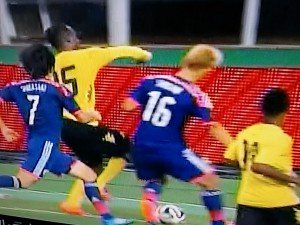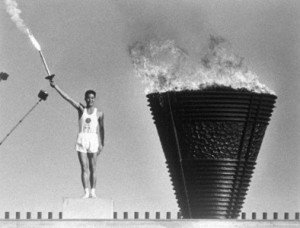How to solve the PGA Tour vs. LIV battle

By Fred Varcoe
How can golf save itself? The advent of LIV has divided the sport and the sport needs to be undivided. The fact that it has been allowed to remain in a state of chaos is a disgrace and nearly all the participants are guilty to some degree. No surprise there. Most sports organizations are run by self-serving, blinkered idiots. They can’t see the bigger picture and don’t want to give up their slice of power. As a result, they don’t have the answers.
Who he?
So, how can a semi-retired sports journalist in Japan have the answer? Well, let me tell you a little story.
The 2002 FIFA World Cup was initially a battle between Japan, South Korea and Mexico. Well, actually, that’s not really accurate. The 2002 World Cup was, effectively, promised to Japan by FIFA’s dastardly president Joao Havelange, the Brazilian Vladimir Putin of football. What was the attraction of Japan, a country that had never qualified for the World Cup? Havelange promised the World Cup to Japan at a time when Japan was arguably the most powerful economy in the world. Japan had stacks of money and, as we all know now, FIFA executives love money.
Unfortunately, not everyone loves Japan, especially South Korea. No way was South Korea going to stand by and allow Japan the glory of hosting the World Cup. So, led by South Korean Football Association President Chung Mong-joon – possibly the most unpleasant and unprincipled man in football, an incredibly high bar that he cleared effortlessly – South Korea joined the party, prompting Mexico to leave it. This party was going to be incredibly expensive.
Inspired by historical hate, the two football associations generously entertained FIFA executives (and their wives) as they made their case to host the World Cup. Japan claimed it had the best football league in Asia – the J. League – while South Korea pointed out that it had qualified for the World Cup five times to Japan’s zero. Both countries had enough money to erect any number of massive stadiums, build roads and hotels, cater to thousands of football fans and express their generosity to FIFA’s executives. All FIFA had to do was to pick one out of two.
By this time, 1995, I had been based in Japan for eight years as a sports writer and I also had a Korean girlfriend. So, I visited both camps, assessed their bids and came up with an answer – the only possible answer.
FIFA hadn’t managed to come up with the right answer and were still staring two wrong answers in the face: Japan or South Korea. FIFA sent a team of experts to assess the merits of the two countries’ bids so that the FIFA Executive Committee could pick a winner.
I knew when the FIFA inspection team would arrive in Japan and on what morning they would read their first morning paper (and I assumed it would be The Japan Times, who I worked for). I ran an article on the back page with the headline, “Cohosting is the only answer for the 2002 World Cup.” And I explained why. The inspection committee – as told to me by a FIFA vice-president – took the cohosting idea back to FIFA headquarters in Zurich and a fight began that ended, as we all know, in the first co-hosted World Cup.
Those are my credentials. I have, of course, come up with many other brilliant ways of improving sport, including how to make football better, but we needn’t go there at present, except to point out that FIFA still thinks penalty shootouts are a good way of deciding a World Cup final. I use this to show how utterly out of touch FIFA can be.
The other example I use relates to the odious Chung. He was once touted as a possible president of FIFA for being “a clean pair of hands.” When I read this in my morning newspaper, I literally spit my porridge all over the table. But I digress. However, I have to mention that the current president of the Korean Football Association is a guy by the name of Chung Mong-gyu, part of the extensive Chung family that controls the Hyundai Group. So, related to Chung Mong-joon who was banned from all football activities for six years by FIFA in October 2015. This was reduced to 15 months because, FIFA told me, of Chung’s “lack of any prior record of unethical behavior, his public stance against corruption within FIFA, and the meritorious services he provided to FIFA and football over the years.” Another table covered with porridge and spit. But I digress.
Indentured, independent contractors
Unlike football, golf doesn’t have a powerful, world governing body like FIFA. It has the R&A in Europe and the USGA in the United States and they generally govern the game of golf and the rules of golf, as well as events like the four majors. There are many tours around the world, including the DP World Tour (formerly the European Tour), the Australasian Tour, the Champions Tour, the Sunshine Tour, the Japan Tour, the Asian Tour, the Korean Tour and, of course, the PGA Tour, which also controls the Korn Ferry Tour and PGA Tour Americas, both of which are feeder tours for the PGA Tour.
And then along comes LIV, throwing cash around to tempt players to abandon their commitments to the PGA Tour and play on an abbreviated but highly lucrative new tour of three-day tournaments with a closed field.
And the insane amounts of cash do their job, pulling in some of the best and most popular players in the world. The PGA Tour cries foul, saying these players are breaching their contracts and have no right to jump ship, even though the PGA Tour calls these players “independent contractors.” I’ve covered this elsewhere, but to recap briefly, if they are independent contractors, surely they are independent from the PGA Tour and free to take their business elsewhere.
But the PGA Tour doesn’t see it like that. The contracts state that these “independent contractors” can’t play anywhere else without permission from the PGA Tour. Sounds like duress and monopoly. Restriction of trade is illegal. In the United States, “restraint of trade covers a broad range of activities, including:
- Creating a monopoly;
- Coercing someone to stop doing business;
- Using non-compete clauses or other contract provisions to prevent someone from conducting business;
- Negatively affecting someone’s ability to conduct business freely.”
I’m not a lawyer, but how does the PGA Tour reconcile this with their designation of golfers as “independent contractors?” Curiously, this hasn’t been tested in court and all lawsuits have been dropped after the PGA Tour and LIV made a provisional business agreement that seems to be lying fallow.
The PGA Tour reacted angrily to LIV and the defecting players, and prompted the DP World Tour to do likewise (although the legal case is still being tested there, so players can still play on the tour). Apart from the majors, the PGA Tour was/ is the pinnacle of golf. That’s where everyone wanted to play, that’s where the competition was best and that’s where the money was … before LIV. But it seems that the PGA Tour wanted to dominate professional golf and was very angry when it found out it couldn’t.
On the surface, LIV’s intervention was a vulgar attack on the PGA Tour. BUT LIV didn’t want to operate in a vacuum and approached the PGA Tour to come to an agreement so that everyone could play golf happily. The PGA Tour refused to talk, and this was a stupid, irrational and self-defeating misstep. LIV didn’t want to destroy the PGA Tour; it wanted to complement it. So the story goes…
But like a jilted husband, the PGA Tour and its lackeys in Europe lashed out, invoking fines and bans for the rebel players. How spiteful were they? Reportedly, players have been fined $100,000 per tournament missed and banned for up to five years. Former PGA Tour winner and now YouTube star Wesley Bryan was suspended by the PGA Tour for appearing in a YouTube event sponsored by LIV, not an actual LIV tournament. Oh, but it gets worse.
As a result of LIV, the PGA Tour has spread its tentacles even further by targeting college players. On May 11, 2022, the PGA Tour announced the following, according to the Golf Channel website:
“For college players hoping to both earn status through PGA Tour University and compete in the LIV Golf Invitational Series, they will now have to pick one or the other. PGA Tour U announced on Wednesday an amendment to its rules of regulations. Effective immediately, players will forfeit their PGA Tour eligibility if they tee it up in a professional tournament that is unranked by the Official World Golf Ranking and not otherwise approved by the PGA Tour. This news comes after last week’s report that LIV Golf had extended membership to the top six players in the World Amateur Golf Ranking, a group that includes several players currently in the PGA Tour U Velocity Global Ranking.”
So, the PGA Tour is trying to destroy golf careers of people who have never been on the PGA Tour.
Resolution No. 9 (and counting)
Clearly, it needs to be resolved. Of course, some people might not want it to be resolved. Tens of players have earned PGA Tour cards because some of the world’s best golfers are playing on the LIV tour. A number have become winners for the same reason. Would Scottie Scheffler be so dominant if Jon Rahm, Brooks Koepka and Bryson De Chambeau were still playing on the PGA Tour? I think not. LIV has created opportunities for many journeyman players on the Korn Ferry and PGA tours and actually that’s a good thing. People can see just how good a golfer ranked #150 or #200 can be. The elitism of the PGA Tour has damaged the game of golf. OK, LIV is a closed shop, but it has livened up the sport and given it new ideas, ideas that the PGA Tour has been happy to steal. I pity those dogmatic haters of LIV who can’t see that a 54-hole tournament with no cut and a shotgun start is always going to be exciting (I’ll pass on the crappy music, thanks).
Lovers of golf do not want to see division and professional golf should provide a stable living for all its practitioners, not just the top 100. The Players Impact Program is an insult to golfers lower down the order. The idea that players who did not jump to LIV should get a bonus is absurd. Everyone has already benefited professionally and financially by the absence of some of the world’s best golfers.
So, we need a settlement. That settlement should make professional golfers true “independent contractors” so that they can play anywhere they want (subject to some eligibility rules). The irony is it’s so easy. By banning LIV golfers from PGA Tour events, it was the PGA Tour that suffered. Talk about shooting yourself in the foot.
The further irony is that the LIV golfers did not want to leave their respective tours and in truth there was no reason why they should have. The top golfers always want to play in the top PGA Tour events, as well as the majors and the Ryder Cup. But the PGA Tour said no and allowed their spite to field weakened fields with golfers that no one had heard of. If the PGA Tour had said, “OK, let’s see how we can make this work,” things would have worked out fine.
Having criticized the PGA Tour, LIV also can’t escape criticism. Its ambush of the PGA Tour and DP World Tour and even college golf was crude and largely unnecessary. Better timing could have allowed the players to voluntarily hand in their PGA Tour cards. It wouldn’t have made the PGA Tour much happier, but it would have allowed them to do things by the book (although, to be honest, I’m not exactly sure what the book says). Having Greg Norman as the face (and mouth) of LIV was always going to be confrontational. That was never going to work out. Norman had tried his World Tour concept before and the PGA Tour didn’t like it.
So, both sides had contributed to the bad blood between them and left me thinking, “This is Japan and South Korea all over again.” And the answer is almost the same: coexistence.
The truth is LIV was never going to do much damage to the PGA Tour. The PGA Tour basically damaged itself. The PGA Tour said players couldn’t play in tournaments that clash with PGA Tour events without permission. This doesn’t make sense. For a start, most of the top golfers play less than half the events in a year and some PGA Tour tournaments clash with (drum roll) other PGA Tour tournaments. Make that make sense. For example, the Truist Championship is held the same week as the ONEflight Myrtle Beach Classic in May. If the PGA Tour can schedule tournaments against itself, why can’t LIV (and let’s not forget tournaments in other parts of the world, especially the DP World Tour, which is played on far more interesting courses than the PGA Tour)?
Here’s an interesting concept for the PGA Tour: make your golfers true independent contractors and eliminate any restrictions about playing events that clash with PGA Tour events. This, I believe, is what golf fans would like to see. It’s not what the PGA Tour wants to see because the PGA Tour wants to dominate and control top-level golf. And it was doing that pretty well until LIV came along. The PGA Tour is basically the U.S. PGA Tour. Nice courses, good players, not a problem. But LIV and the DP World Tour have shown that there’s a lot of exciting golf played in many, many different countries on some fantastic courses. And results have shown that complete unknowns can come through and play with the elite. Wesley Bryan, pro golf’s St. Sebastian, recalls how he was a nobody doing trick shots on YouTube one year and a PGA Tour winner and top 50 golfer the next year.
Freedom is only going to benefit golf. I’m not saying that the PGA Tour shouldn’t make rules or even require a minimum number of tournaments, but it can rationalize its current system. Tennis did that by grading its tournaments and awarding points accordingly. The world tours can come up with a universal grading system (which it kind of has already for world ranking points) and apply it to their tours. The players can then decide their own schedules. I’m pretty sure the PGA Tour will still win out. Three of the majors are still in the U.S., plus the Players Championship. (I would like to see a World Major added to the international golf schedule, classifying it as a major and moving it to different parts of the world every year). Hopefully, LIV will qualify for OGWR next year and Jon Rahm won’t be ranked No. 81. It will be in LIV’s interests to make a schedule based around the PGA Tour schedule, partly to ensure that the top players will play and also to avoid antagonizing the PGA Tour.
Punishment and compromise
That’s all good, but we still have to deal with LIV. The establishment of another tour outside the mainstream is nothing new and new events often come up with great new ideas, as you can see in other sports such as cricket, volleyball and not football. LIV has shaken up golf and made it realize that the traditional four-day tournament doesn’t have to define tournament golf. But LIV’s ambush of the PGA Tour was dirty and only achieved by throwing obscene amounts of money at players. In its current format, it’s unsustainable. We’ll get to that.
The elephant in the room is punishment. The PGA Tour and the DP World Tour went nuts, banning players outright and imposing ludicrously high fines (many of which LIV has paid). Should the players have been punished? Probably, yes, but that “independent contractor” thing is still rattling around in the background. Let’s remember, the PGA Tour wants the top players back, so imposing fines of $100,000 a week is just stupid. If you want the players back, you have to find a reasonable way to do it. So, step 1: fine the players according to their status in the game, which can be determined by how much they’ve taken home in prize money during their career.
Phil Mickelson will be at the top end of that scale, having won nearly $97 million. Fine him 1 percent of that total. Alternatively, you could come up with a system based on how many tournaments he’s competed in or won, but there’s no reason to make it complicated. A $970,000 fine for Phil makes sense to me.
The second part of re-integration is more difficult: ranking. Phil, a guy who won the PGA Championship four years’ ago, is currently No. 1,159 in the world. My feeling is that the LIV players have to start at a lower level. They can’t just jump back to their previous status. Where applicable, I would allow the top LIV players back into tournaments on sponsor exemptions because then the PGA Tour gets what it wants: the top players. Those lower down the totem pole will have to earn their places back. If they were on the DP World Tour or the Asian Tour, then those tours can decide how to allow them back. Many players have benefited – professionally and financially – from the absence of LIV players from the various tours, so it’s up to those LIV players to fight their way past this new batch of players on merit and earn their place back at the top table. A one-time massive Q school perhaps.
Long live LIV
If it sounds like I’m talking about the end of LIV, then I’m not. I like LIV. I like the 54-hole, shotgun start format and I think the PGA Tour should hold similar events. But I don’t see LIV as financially sustainable in its current format. One of my earlier ideas to change LIV was to make it a four-day event with the team event based on the fourth day of play. All four days would go to deciding the individual winner but the teams for the fourth day would be decided by the results of the first three days. So, Team 1 would consist of the players who finished first, 13th, 25th and 37th. Team 2 would consist of the players who finished second, 14th, 26th and 38th, and so on.
That works fine and would be exciting except that LIV’s financial goals include making the team into money-making franchises. Having different players every week wouldn’t fit that model. But the current model – four players to a team – is too restrictive and if a player’s injured, the team’s down to three or using a sub. My idea is that each team consists of a squad of eight to 10 players. Now, remember, this will work out if the players really are “independent contractors,” so that players can switch between tours during the season. Sure, LIV can tie a few down with appearance fees to make sure the teams don’t consist of college players, but my vision is to have eight to 10 top players in a squad but still only have four players representing a team in any given week (although if there’s no clash with other events, having all eight or 10 players play over four days would be really cool).
And that system takes my next idea a step further: the LIV Tour should be a TEAM EVENT ONLY. Fans love team events and LIV has clearly been trying to capitalize on that, but not very successfully. The team element is always secondary to the individual competition. Put it as the focus of LIV and you have a dynamic, fan-friendly event (hopefully with better names than Smash or the Cleeks). Then, the franchise system will work. Fans would love it, broadcasters would love it, sponsors would love it, and money-grubbing agents and businessmen would love it.
The PGA Tour has already agreed, provisionally, to work with LIV and it could do with LIV’s proposed $1.5 billion dollar donation. I would like to see some of the money in golf going further down the totem pole. Professional golf needs to look at itself in the mirror. If it was starting from scratch, how would it be organized? Probably a lot better than it’s being organized at present.
****
APPENDIX 1
After writing this, I smashed my sources into Google Gemini to see what kind of solution AI would come up with. I’ll leave it here….
****
Based on reports, expectations from players, and demands from major sponsors, the fundamental solution to the conflict between the PGA Tour and LIV Golf involves unity, financial reconciliation, and structural concessions from all parties, especially the three major entities: the PGA Tour, the DP World Tour, and the PIF/LIV Golf.
Key solution paths and necessary compromises identified in the sources include:
1. Corporate Merger and Financial Integration
The most widely discussed solution involves merging the competing financial interests under one roof, often cited as the only solution by those invested in the game’s future.
• PIF Investment into PGA Tour Enterprises: The Saudi Public Investment Fund (PIF), which funds LIV, is reportedly close to finalizing a massive investment into the new PGA Tour Enterprises, which was established earlier this year. Reports claim a deal is finalized or nearing completion that could see PIF invest as much as £1.5 billion into the PGA Tour.
• LIV under PGA Tour’s “Umbrella”: This corporate deal would reportedly result in LIV Golf coming under the PGA Tour’s operational “umbrella,” with the PIF taking an equity stake and receiving representation on the PGA Tour Enterprises board.
• Loyalty Compensation: To resolve financial friction with loyal PGA Tour players, the PIF’s investment is claimed to include funds set up to reward players who rejected massive LIV offers. Alternatively, the PGA Tour loyalists could receive equity stakes in PGA Tour Enterprises.
• Concessions: DP World, a major sponsor, is demanding that all parties recognize the necessity for “concessions and conciliations” to achieve the unified outcome that fans and sponsors desire.
2. Player Reintegration and Scheduling Compromises
A major challenge is determining how LIV players return, and how to restructure the global calendar to bring the world’s best players back together consistently.
• Free Movement Between Tours: LIV player Jon Rahm stated that his ideal merger would allow golfers to “play freely between tours” to enjoy specific major tournaments (like the American Express or Torrey Pines) while maintaining DP World Tour membership for fall events.
• Selective Return Based on Merit: PGA Tour player Wyndham Clark suggested that golfers with strong resumes, such as major winners like Dustin Johnson and Brooks Koepka, have earned the right to return without sanctions, whereas players who lacked that pedigree and left primarily for money should face difficulty returning.
• Avoiding Antitrust Issues: Legal concerns related to antitrust laws mean that LIV Golf will likely need to continue operating in some form after a deal is reached, possibly with a calendar condensed to the autumn to avoid conflicting with major PGA Tour events.
• Specific Access Proposal: Former Ryder Cup captain Paul McGinley proposed a structural solution where the top 10 LIV golfers are granted access to five PGA Tour Signature Events and The Players Championship. In return, the PGA Tour could field two teams in LIV’s season-ending Team Championship.
• LIV Format Change: LIV Golf has independently begun working toward legitimacy by announcing a shift from its controversial 54-hole format to the traditional 72-hole format starting in the 2026 season. This change is intended to satisfy Official World Golf Ranking (OWGR) criteria, which would allow its players to automatically qualify for Majors and remove a major institutional barrier.
3. Structural Changes and Governance
To stabilize the “product” for sponsors, some propose that the PGA Tour adopt elements of the LIV model.
• Mandatory Player Attendance: Paul McGinley argued that the PGA Tour must “evolve away from being a members organization” that treats players as independent contractors free to pick and choose events. He advocates for the PGA Tour administration to take “more in control of the product” by using contracts to obligate top players to play certain events, similar to LIV Golf.
• Global Calendar and DPWT Focus: Sponsors like DP World are demanding a resolution that includes a more integrated tour throughout the year, promoting DP World Tour (DPWT) events and encouraging greater participation from American players outside of the U.S. season. Rory McIlroy has also stated that his vision is for a global calendar.
• DPWT Leverage: The possibility of LIV Golf pursuing a separate deal with the DP World Tour could provide the European circuit with leverage to secure its standing in any future unified golf landscape.





















